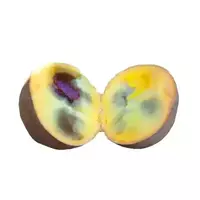Boiled

The fruit tree, called kepel (Stelechocarpus burahol), belongs to the Annon family and is a subspecies of the genus Stelechocarpus. In general, the cap is considered endemic, that is, limited in its distribution by a relatively small area, the plant of the island of Java - it is there that it can be found at an altitude of less than 600 meters above sea level. In addition, although it is extremely rarely cultivated in some areas of Asia (in the southeast), in Central America, Northern Australia (Queensland), as well as in Florida.
The evergreen tree has a rather large height (up to twenty-five meters) and powerful branches, the width of which often reaches 40 centimeters. The dark green leaves of the kepela differ in oval-lanceolate or elongated-oval shape, they are shiny thin-leathery and smooth. Greenish-white or slightly reddish kepela flowers - same-sex, with short pedicels. By the way, female flowers were much larger than male flowers - up to three centimeters in diameter, they grow in bundles at the bottom of the trunk. And male flowers, on the contrary, develop in the upper part.
The fruits of kepel are berries that grow at the bottom of the trunk for quite long (up to 8 centimeters). They differ in oval or round shape and the following dimensions: up to
4. 5 centimeters wide with a length of up to 6 centimeters. The fruits of the kepela are covered by a thin brown leathery rough peel.
The flesh of the mature kepela fruit is colored orange or brown, it is distinguished by the juiciness, sweetness and aroma characteristic of violet. The rather large seeds of kepela brown, which are contained in each fruit of four to six pieces, have an oval shape. By the way, sometimes you can also find seedless fruits.
It is worth noting that adult kepela trees can produce a fairly rich harvest annually - more than a thousand fruits. The fruit is considered ripe and edible as soon as the skin, which is located under a brown rough surface, changes its color from green to yellow or light brown.
It is customary to consume the flesh of ripe kepela fruits in raw form. Kepela juice has a deodorizing property, and when applied to the skin of a person, it smells of violet aroma. It should be mentioned that the use of kepel fruits in women can provoke temporary infertility, and therefore this fruit is often used as a natural contraceptive.
Traditionally, on the island of Java, the family of the Sultan of Jakarta had the right to possess this tree, and its fruits were used by the local population as a cosmetic. To date, the tree has not lost its aristocratic reputation among the inhabitants of Central Java.
kepela 47 kKal
Energy value of kepela (Ratio of proteins, fats, carbohydrates - ju):
Proteins: 0.9 g (~ 4 kCal)
Fats: 0.4 g (~ 4 kCal)
Carbohydrates: 9.8 g (~ 39 kCal)
Energy ratio (bj | y): 8% | 8% | 83%
 Español
Español Français
Français Português
Português Русский
Русский 简体中文
简体中文 繁體中文
繁體中文 日本語
日本語 한국어
한국어 العربية
العربية Türkçe
Türkçe Қазақ
Қазақ Deutsch
Deutsch Italiano
Italiano Українська
Українська
